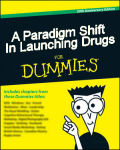Jamzo points us to this OPED on Pharmalot by:
Peter Hansen, who is the senior manager and global product launch lead for the Accenture Life Sciences industry practice, to explain what drugmakers need to know and do if they want to bring a medicine not just from the lab to FDA offices, but also into patient hands…
No offense to Ed Silverman or Peter Hansen intended, but they might think about adding an alternative section called A Paradigm Shift In Launching Drugs for Dummies to accommodate those of us who arrived in adulthood in an earlier century, and have trouble believing that people can actually think these thoughts. Another possibility would be to stamp it No Country for Old Men. I at least get the opening paragraph:
Many drugmakers have had a difficult few years, saddled with a lack of blockbuster drugs, fewer promising compounds in the product development pipeline, and challenges from generics as blockbusters lose their patent and exclusivity protection. These issues have been evolving over a number of years, and as a result many drugmakers have not been able to change their models of doing business during this time. Instead, many have maintained traditional approaches of selling therapeutics, rather than moving toward more selective, targeted and personalized approaches that more intimately engage everyone from the patient, to the physician, to payers, providers and other key stakeholders…
For instance, drugmakers should be establishing deeper relationships with a broader key opinion leader population. Rather than trying to develop close relationships with the top global KOLs, they must establish reach out to KOLs at the global, regional, national and local levels. There also is a need to rely more heavily on scientific exchange, for instance.
There’s a developing and very real complaint gap. I haven’t even factored in the personalized medicine trend:
In addition, marketing teams have to be much more sophisticated in how they utilize their resources. For drugs in the personalized medicine arena, the market involves smaller patient populations, and the result is smaller peak sales, and therefore, smaller budgets. Brands must factor in such issues as KOL influence, institutional influence and payer status, and understand the impact of these forces at the local geographic level. The ability to rank geographies according to influence and payer status is a much more sophisticated approach to targeting that pharmaceutical companies are beginning to utilize and should see wider adoption…
or who is doing the prescribing:
In the past, the physician handed down a decision to the payer and the patient. But now decisions are being made by different stakeholders in the health care environment, including the patients themselves. In some geographies, decision making is shifting into the hands of the payers; in other geographies, the decision-making is moving into the hands of health care networks, payers and regulators.
or who is doing the selling AKA 21st century rep technology:
There is also a need to use a targeted approach that entails a portfolio of different types of sales reps, ranging from high science to high-service personnel. The high science rep may be the best to engage the new type of decision makers. This person may be a medical doctor, or have a scientific or nursing background. They will be scientifically well versed, and will be able to have in-depth clinical discussions about the merits of a therapeutic, offering various research and clinical trial data to support any claims and not just sales messages. The focus would be on education and information and not just on a “hard sell.” The tactic would be to address fellow experts in an engaging scientific-based conversation rather than to only promote a product.In comparison, the high-service rep would have the task of blanketing physicians’ offices with samples, educational materials and other supplies. Their job is not to market the product, but to ensure that doctor offices have the required number of samples and reading materials. These reps could conceivably make more than two dozen office calls daily.
Sales forces would also make use of traditional reps in offices where the physicians still have the freedom to make their own prescription decisions. These reps would have the more common role of engaging the physician, delivering the marketing message and answering basic questions about the product.
And that’s about all I can take in my summarizing. There’s plenty more… Oh, Okay. One more for the road:
Effective launch strategies focus not just on tracking, understanding and targeting the physicians who write the script. They must also focus on a much broader group of people who influence the script—including patient advocates and social media KOLs, such as conference speakers and specialists. The key to success is to build a robust KOL network that extends beyond the top 20 most well known national KOLs into the top 100 regional and local KOLs as well.
Like I said, this is definitely No Country for Old Men…

Sorry, the comment form is closed at this time.